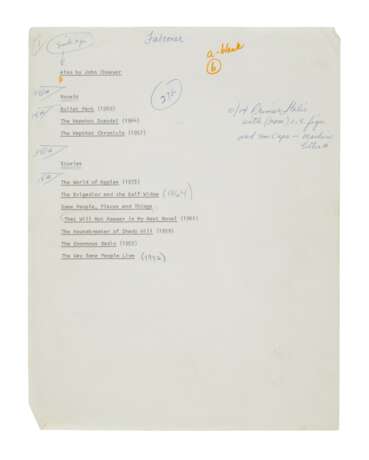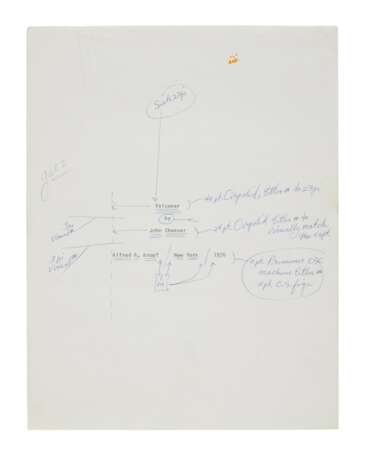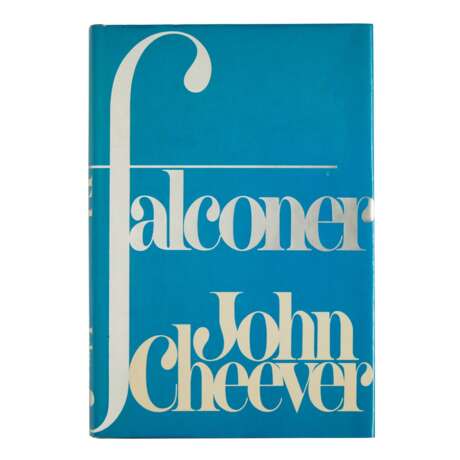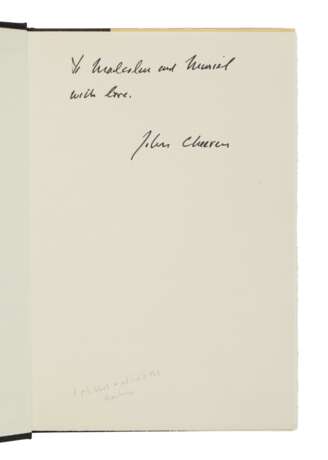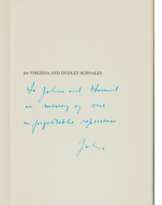ID 1105457
Lot 10 | Cheever, John | The final, corrected typescript of his 1977 novel Falconer
Valeur estimée
$ 20 000 – 30 000
The final, corrected ribbon typescript of his 1977 novel Falconer
214 leaves (280 x 228 mm) on typing paper (watermarked Eagle A Coupon Bond 100% Cotton Fiber USA), numbered 1.–135., 136–136-a (inserted leaves on different paper and typed in different font), 137.–203., 203-a (inserted leaf on different paper and typed in different font), 204.–211., heavily marked for publication by at least six successive proofreading, copyediting, and design hands in graphite, green and orange pencil, and blue, black, and red ink, four leaves with typed revisions in a different font and on different paper pasted over original (or excised) text in the manner of cancel slips, occasional use of white-out for revision or deletion; the author’s typescript preceded by six leaves of typed preliminaries evidently supplied by the publisher (on typing paper watermarked Chieftain Bond 50% Cotton Fiber, the same as that used for the insertions and cancels in the text typescript); final leaf a bit worn and frayed at margins, but generally fine condition considering the number of Knopf hands involved. Housed in a half blue morocco slipcase fitted with two blue cloth chemises with a number of related items:
a typed letter signed by then-Knopf editorial assistant Lee Georner (d. 1995), 9 March 1977, returning the typescript to Cheever, "Before it's misplaced, I thought I should send you the original mss. of Falconer, which I thought you'd like to have. …";
a publisher’s proof, or mock-up, of the first edition of Falconer (New York: Alfred A. Knopf, 1977; loose stapled quires with an original penciled design of the title-page ), signed by Cheever on the half-title, and possibly sent to the critic Malcolm Cowley;
a typed letter signed by Knopf publicity director William T. Loverd to Cowley, 28 February 1977, apologizing for the delay in thanking him for his "fine words about John Cheever's new novel, FALCONER. They were the first to be received, leading the way to what we feel sure will be a magnificent success for John. …";
a Knopf advertising flyer featuring Cowley’s blurb of the novel, Falconer is an extraordinary novel, the story of a sensitive man driven to drug addiction, who sinks in the world until he falls through the bottom, and then is reborn into what we feel will be a new life. … Cheever tell it … with reverence for life in all its forms, and with unforgettable characters.";
a presentation copy of the published first edition of Falconer, inscribed by Cheever on the front free endpaper to Mr. and Mrs. Cowley, "To Malcolm and Muriel with love, John Cheever."
A very good collection related to Cheever's most successful, if least characteristic, novel. The genesis of Falconer—the story of a drug addict fratricide and what he learns while serving ten years in Falconer prison—was the writing classes Cheever taught at the maximum security Sing Sing Correctional Facility in his hometown of Ossining, New York, in the early 1970s. Blake Bailey’s Cheever: A Life states that "Almost every set piece in Falconer—almost every detail—appears somewhere in Cheever’s journal entries about Sing Sing."
Among the hundreds of proofing and copyediting changes on the typescript perhaps the most intriguing is the correction on page 175 of the name of the titular prison from the homophone Faulkner. The most substantial textual change appears on the final page: the final clause of what had been the final sentence of novel is ruled through in pencil ("He held his head high, his back straight, and walked along nicely, as if this was his rightful place in things.") and a new concluding sentence has been typed in with a different typewriter, "Rejoice, he thought, rejoice."
Primary material relating to Cheever's writing is notoriously scarce on the market.
| Artiste: | John William Cheever (1912 - 1982) |
|---|---|
| Catégorie maison de vente aux enchères: | Impressions, graphiques, livres |
| Artiste: | John William Cheever (1912 - 1982) |
|---|---|
| Catégorie maison de vente aux enchères: | Impressions, graphiques, livres |
| Adresse de l'enchère |
Sotheby´s 1334 York Avenue 10021 New York Etats-Unis | ||||||||||||||
|---|---|---|---|---|---|---|---|---|---|---|---|---|---|---|---|
| Aperçu |
| ||||||||||||||
| Téléphone | +1 212 606 7000 | ||||||||||||||
| Conditions d'utilisation | Conditions d'utilisation | ||||||||||||||
| Heures d'ouverture | Heures d'ouverture
|

